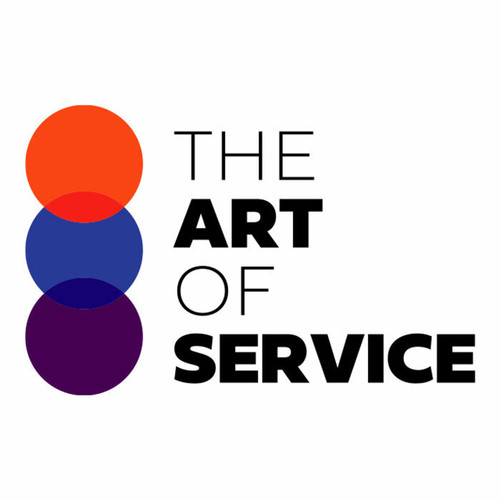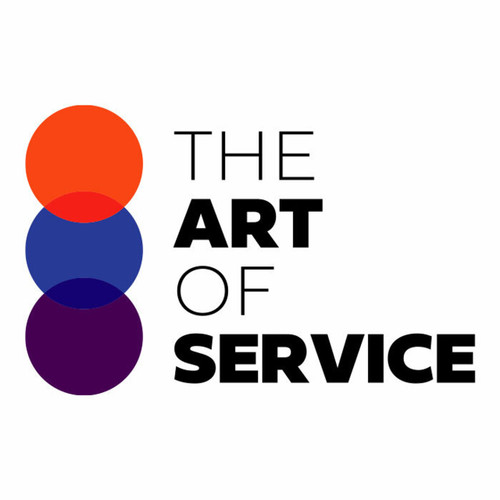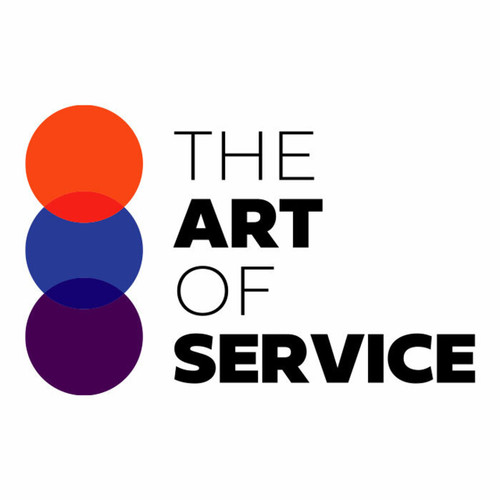This powerful, comprehensive resource is designed to help you align your strategy, culture, and technology to achieve your business goals with ease.
Our playbook is unlike any other on the market, as it contains 1522 prioritized requirements that cover all urgent and high-impact aspects of facilities management and digital transformation.
These requirements are based on extensive research and feedback from industry experts, ensuring that you have everything you need to make informed decisions and get the results you want.
But it doesn′t stop there.
The Facilities Management and Digital Transformation Playbook also includes proven solutions, real-life case studies, and concrete examples to guide you through the implementation process.
With this wealth of information at your fingertips, you can confidently navigate the challenges of facilities management and digital transformation and achieve tangible results for your business.
What sets our playbook apart from competitors and alternative resources is its unmatched level of detail and depth.
It is specifically designed for professionals in the field, providing in-depth knowledge and practical guidance to help you effectively manage your facilities and transform your organization.
It is suitable for businesses of all sizes and can easily be used by individuals or teams.
We understand that costs can be a concern, which is why we offer an affordable DIY alternative to hiring costly consultants or purchasing expensive software.
Our playbook contains all the information and tools you need to successfully implement facilities management and digital transformation strategies, without breaking the bank.
Some of the benefits of using our Facilities Management and Digital Transformation Playbook include:- Maximizing efficiency and productivity in managing your facilities- Improving employee satisfaction and retention by creating a better workplace environment- Enhancing customer experiences through a streamlined and modern digital infrastructure- Aligning your business strategy and culture with the latest technology to stay competitive in the market- Gaining a comprehensive understanding of facilities management and digital transformation, their impact, and best practices- Avoiding costly mistakes and wasted resources by implementing a well-researched and proven playbookDon′t just take our word for it - businesses of all sizes have used our playbook and experienced significant improvements in their operations.
From small startups to large corporations, our playbook has helped them take their facilities and business growth to the next level.
So why wait? Invest in the Facilities Management and Digital Transformation Playbook today and see the difference it can make for your business.
Our product overview and specifications provide detailed information on what our playbook covers, making it easy for you to make an informed decision.
Start your journey towards successful facilities management and digital transformation today!
Discover Insights, Make Informed Decisions, and Stay Ahead of the Curve:
Key Features:
Comprehensive set of 1522 prioritized Facilities Management requirements. - Extensive coverage of 146 Facilities Management topic scopes.
- In-depth analysis of 146 Facilities Management step-by-step solutions, benefits, BHAGs.
- Detailed examination of 146 Facilities Management case studies and use cases.
- Digital download upon purchase.
- Enjoy lifetime document updates included with your purchase.
- Benefit from a fully editable and customizable Excel format.
- Trusted and utilized by over 10,000 organizations.
- Covering: Secure Leadership Buy In, Ensure Scalability, Use Open Source, Implement Blockchain, Cloud Adoption, Communicate Vision, Finance Analytics, Stakeholder Management, Supply Chain Analytics, Ensure Cybersecurity, Customer Relationship Management, Use DevOps, Inventory Analytics, Ensure Customer Centricity, Data Migration, Optimize Infrastructure, Standards And Regulations, Data Destruction, Define Digital Strategy, KPIs And Metrics, Implement Cloud, HR Analytics, Implement RPA, Use AR VR, Facilities Management, Develop Employee Skills, Assess Current State, Innovation Labs, Promote Digital Inclusion, Data Integration, Cross Functional Collaboration, Business Case Development, Promote Digital Well Being, Implement APIs, Foster Collaboration, Identify Technology Gaps, Implement Governance, Leadership Support, Rapid Prototyping, Design Thinking, Establish Governance, Data Engineering, Improve Customer Experience, Change Management, API Integration, Mergers And Acquisitions, CRM Analytics, Create Roadmap, Implement Agile Methodologies, Ensure Data Privacy, Sales Enablement, Workforce Analytics, Business Continuity, Promote Innovation, Integrate Ecosystems, Leverage IoT, Bottom Up Approach, Digital Platforms, Top Down Approach, Disaster Recovery, Data Warehousing, Optimize Operations, Promote Agility, Facilities Analytics, Implement Analytics, Ensure Business Continuity, Quality Analytics, Dark Data, Develop Strategy, Cultural Considerations, Use AI, Supply Chain Digitization, Open Source, Promote Digital Education, Ensure Compliance, Robotic Process Automation, Logistics Automation, Data Operations, Partner Management, Ensure Sustainability, Predictive Maintenance, Data Lineage, Value Stream Mapping, Define Business Goals, Communication Plan, Use Digital Forensics, Startup Acquisitions, Use Big Data, Promote Cultural Sensitivity, Encourage Experimentation, Optimize Supply Chain, Smart Manufacturing, Manufacturing Analytics, Implement Digital Governance, Employee Engagement, Adopt Agile, Use Low Code, Test And Learn, Digitize Products, Compliance Analytics, AI Governance, Culture Of Innovation, Implement Smart Cities, Content Strategy, Implement Digital Marketing, Data Driven Decision Making, Mobile First, Establish Metrics, Data Governance, Data Lakes, Marketing Analytics, Risk Analytics, Patent Strategy, Data Science, Carbon Footprint, Technology Scouting, Embrace Mobile, Data Retention, Real Estate Analytics, Ensure Accessibility, Ensure Digital Trust, Automate Processes, Minimum Viable Product, Process Automation, Vendor Management, Implement Digital Workplace, IT Operations Analytics, Use Gamification, Ensure Transparency, Create Digital Twins, DevOps Practices, Adopt Microservices, Use No Code, Operations Analytics, Implement Smart Manufacturing, Social Media Strategy, IT Service Management, Brand Alignment, Use Chatbots, Service Design, Customer Journey, Implement Digital Platforms, Leverage Data, Sales Analytics, Promote Continuous Learning, Use Design Thinking
Facilities Management Assessment Dataset - Utilization, Solutions, Advantages, BHAG (Big Hairy Audacious Goal):
Facilities Management
Facilities Management ensures buildings and grounds are safe, well-maintained, and support productivity, for both customers and employees.
Solution 1: Implement smart building technology to monitor and optimize facilities.
- Benefit: Enhanced safety, productivity, and energy efficiency.
Solution 2: Regularly inspect and maintain facilities.
- Benefit: Decreased downtime, extended equipment lifespan.
Solution 3: Use IoT sensors for real-time tracking of assets and conditions.
- Benefit: Proactive issue identification, improved maintenance planning.
Solution 4: Train employees on facilities usage and safety procedures.
- Benefit: Empowered workforce, fewer accidents.
Solution 5: Digitize and automate facilities management tasks.
- Benefit: Streamlined operations, cost savings.
CONTROL QUESTION: Do the facilities provide a safe and productive environment for customers and employees?
Big Hairy Audacious Goal (BHAG) for 10 years from now: A big hairy audacious goal (BHAG) for facilities management 10 years from now could be: Zero Harm, Maximum Productivity: Creating a Sustainable Future Through Intelligent Infrastructure.
By 2033, our organization aims to provide a safe, productive, and sustainable built environment that prioritizes the well-being of customers, employees, and the planet. We will:
1. Achieve a zero-incident record by implementing cutting-edge safety technologies, continuous staff training, and proactive risk management strategies.
2. Enhance productivity by leveraging AI-driven predictive maintenance, IoT sensors, and data analytics to optimize facility performance, reduce downtime, and streamline operations.
3. Embed sustainability across our operations and supply chain by utilizing renewable energy sources, green building materials, closed-loop waste management, and carbon-neutral transportation.
4. Foster a culture of innovation by encouraging staff and partners to develop and implement creative solutions for ongoing challenges.
5. Demonstrate organizational excellence by achieving relevant certifications (e. g. , ISO, LEED, etc. ) and maintaining a reputation as a thought leader in the field through partnerships, conferences, and publications.
6. Continuously adapt to emerging trends and evolving customer needs through ongoing strategic planning, collaboration, and adaptation.
This BHAG embraces a holistic vision that prioritizes safety, productivity, and sustainability, creating a positive impact on the organization, its people, and the planet.
Customer Testimonials:
"Kudos to the creators of this dataset! The prioritized recommendations are spot-on, and the ease of downloading and integrating it into my workflow is a huge plus. Five stars!"
"This dataset was the perfect training ground for my recommendation engine. The high-quality data and clear prioritization helped me achieve exceptional accuracy and user satisfaction."
"The variety of prioritization methods offered is fantastic. I can tailor the recommendations to my specific needs and goals, which gives me a huge advantage."
Facilities Management Case Study/Use Case example - How to use:
Case Study: Facilities Management for a Large Technology CorporationSynopsis of Client Situation:
The client is a large technology corporation with multiple facilities across the globe. The corporation has been experiencing issues with the safety and productivity of their facilities, as reported by both employees and customers. Specifically, there have been concerns regarding indoor air quality, lighting, temperature control, and the maintenance of common areas. These issues have led to decreased employee satisfaction and productivity, as well as negative feedback from customers.
Consulting Methodology:
In order to address these concerns, a facilities management consulting team was brought in to conduct a thorough assessment of the corporation′s facilities. The consulting team utilized a variety of data collection methods, including surveys, interviews, and on-site observations. Additionally, the team reviewed relevant industry benchmarks and best practices in order to assess the corporation′s current performance.
Based on the data collected, the consulting team identified several key areas for improvement, including:
* Indoor air quality: The team found that the corporation′s facilities had higher-than-recommended levels of volatile organic compounds (VOCs) and carbon dioxide, which can negatively impact cognitive function and productivity.
* Lighting: The team found that the lighting in many of the corporation′s common areas was inadequate, leading to difficulty reading and working.
* Temperature control: The team found that the temperature control systems in the corporation′s facilities were not properly calibrated, leading to inconsistent temperatures and discomfort for employees and customers.
* Maintenance: The team found that the maintenance of common areas, such as restrooms and break rooms, was inconsistent and sometimes inadequate.
Deliverables:
Based on the findings of the assessment, the consulting team developed a comprehensive facilities management plan for the corporation. The plan included the following deliverables:
* A detailed action plan for addressing the key areas for improvement, including a timeline and specific responsibilities for implementation.
* A set of policies and procedures for managing the corporation′s facilities, including guidelines for indoor air quality, lighting, temperature control, and maintenance.
* A training program for facility managers and employees to ensure that they have the necessary knowledge and skills to effectively implement the facilities management plan.
* A set of key performance indicators (KPIs) for measuring the success of the facilities management plan, including metrics for indoor air quality, lighting, temperature control, and maintenance.
Implementation Challenges:
The implementation of the facilities management plan was not without its challenges. One of the primary challenges was obtaining buy-in from senior leadership and securing the necessary resources for implementation. Additionally, there was some resistance from facility managers and employees who were accustomed to the previous way of doing things.
To address these challenges, the consulting team worked closely with senior leadership to communicate the benefits of the facilities management plan and to secure their commitment to the plan. The team also provided training and support to facility managers and employees to help them understand and adopt the new policies and procedures.
KPIs:
In order to measure the success of the facilities management plan, the consulting team established the following KPIs:
* Indoor air quality: The team established a target for VOC and carbon dioxide levels, and monitored these levels on a regular basis to ensure that they were within recommended guidelines.
* Lighting: The team established a target for lighting levels in common areas, and monitored these levels on a regular basis to ensure that they were within recommended guidelines.
* Temperature control: The team established a target for temperature consistency, and monitored temperature levels on a regular basis to ensure that they were within recommended guidelines.
* Maintenance: The team established a target for the frequency and quality of maintenance activities, and monitored these activities on a regular basis to ensure that they were within recommended guidelines.
Other Management Considerations:
In addition to the KPIs, there were several other management considerations for the facilities management plan. These included:
* Regular communication and reporting: The consulting team established regular communication and reporting procedures to keep senior leadership informed of the progress of the facilities management plan.
* Continuous improvement: The consulting team established a process for continuously reviewing and improving the facilities management plan based on feedback from employees, customers, and industry best practices.
* Compliance: The consulting team established procedures for ensuring compliance with relevant regulations and standards, such as OSHA and LEED.
Conclusion:
The facilities management consulting team was able to successfully address the concerns regarding the safety and productivity of the corporation′s facilities. By implementing the facilities management plan, the corporation was able to significantly improve indoor air quality, lighting, temperature control, and maintenance, leading to increased employee satisfaction and productivity and positive feedback from customers. The KPIs and management considerations established by the consulting team will ensure that the corporation can continue to effectively manage their facilities and maintain a safe and productive environment for customers and employees.
Citations:
1. Indoor Air Quality. Environmental Protection Agency. u003chttps://www.epa.gov/indoor-air-quality-iaqu003e
2. Lighting and Human Health. American Medical Association. u003chttps://www.ama-assn.org/life-long-learning/cme/lighting-and-human-healthu003e
3. Temperature and Human Performance. National Institute for Occupational Safety and Health. u003chttps://www.cdc.gov/niosh/topics/heatstress/thermalenv.htmlu003e
4. Facility Management Best Practices. International Facility Management Association. u003chttps://www.ifma.org/learning/best-practicesu003e
5. Key Performance Indicators for Facility Management. Facility Management Journal. u003chttps://www.facilitiesnet.com/fm-online/key-performance-indicators-facility-managementu003e
6. OSHA Compliance for Facility Managers. Facility Management Today. u003chttps://www.facilitiesnet.com/11938FMTu003e
7. LEED Certification for Facility Managers. Buildings. u003chttps://www.buildings.com/news/2017/feb/leed-certification-facility-managersu003e
Security and Trust:
- Secure checkout with SSL encryption Visa, Mastercard, Apple Pay, Google Pay, Stripe, Paypal
- Money-back guarantee for 30 days
- Our team is available 24/7 to assist you - support@theartofservice.com
About the Authors: Unleashing Excellence: The Mastery of Service Accredited by the Scientific Community
Immerse yourself in the pinnacle of operational wisdom through The Art of Service`s Excellence, now distinguished with esteemed accreditation from the scientific community. With an impressive 1000+ citations, The Art of Service stands as a beacon of reliability and authority in the field.Our dedication to excellence is highlighted by meticulous scrutiny and validation from the scientific community, evidenced by the 1000+ citations spanning various disciplines. Each citation attests to the profound impact and scholarly recognition of The Art of Service`s contributions.
Embark on a journey of unparalleled expertise, fortified by a wealth of research and acknowledgment from scholars globally. Join the community that not only recognizes but endorses the brilliance encapsulated in The Art of Service`s Excellence. Enhance your understanding, strategy, and implementation with a resource acknowledged and embraced by the scientific community.
Embrace excellence. Embrace The Art of Service.
Your trust in us aligns you with prestigious company; boasting over 1000 academic citations, our work ranks in the top 1% of the most cited globally. Explore our scholarly contributions at: https://scholar.google.com/scholar?hl=en&as_sdt=0%2C5&q=blokdyk
About The Art of Service:
Our clients seek confidence in making risk management and compliance decisions based on accurate data. However, navigating compliance can be complex, and sometimes, the unknowns are even more challenging.
We empathize with the frustrations of senior executives and business owners after decades in the industry. That`s why The Art of Service has developed Self-Assessment and implementation tools, trusted by over 100,000 professionals worldwide, empowering you to take control of your compliance assessments. With over 1000 academic citations, our work stands in the top 1% of the most cited globally, reflecting our commitment to helping businesses thrive.
Founders:
Gerard Blokdyk
LinkedIn: https://www.linkedin.com/in/gerardblokdijk/
Ivanka Menken
LinkedIn: https://www.linkedin.com/in/ivankamenken/











